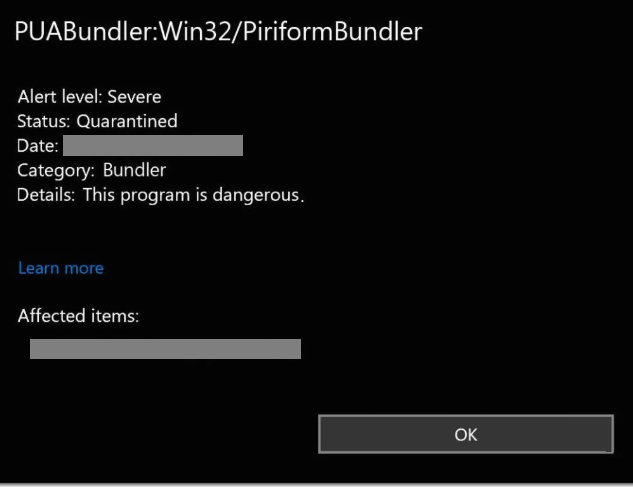Remove PUA:Win32/PiriformBundler
PUA:Win32/PiriformBundler is the detection name used by anti-virus programs like Microsoft Defender to detect potentially unwanted programs (PUPs) developed by Piriform Software. Programs detected using this detection name are not necessarily malicious, but they have features that many anti-virus programs consider unwanted. Specifically, the programs’ use of software bundling is what makes them problematic. What’s more, many of the programs developed by Piriform Software are system optimizers, which are not necessary in most cases.
Microsoft detects Piriform Software programs that come with bundled offers as PUA:Win32/PiriformBundler. Software bundling is often very problematic because it introduces a lot of junk onto users’ computers without their explicit consent. It’s very common for anti-virus programs to detect programs that use this method as potentially unwanted, and for good reason.
Anti-virus programs often assign detection names to families of PUPs that share the same developer and characteristics, as is the case with PUA:Win32/PiriformBundler. While Piriform Software does not release malware, it mainly specialises in system optimizers. These types of programs are often quite controversial, and there are many divided opinions about them. System optimizers promise to improve a computer’s performance by deleting large files, clearing cookies, etc., but they’re not particularly effective. In many cases, system optimizers are entirely useless, and the fact that they often require a paid subscription to use is even more problematic.
If Microsoft Defender is detecting a program as PUA:Win32/PiriformBundler, it likely had some unwanted junk attached to it when you installed it. Commonly, software bundling introduces adware, browser hijackers, and useless toolbars. While potentially unwanted programs are not malware, they do have many questionable features.
How to avoid bundled installations
The main concern with Piriform Software programs is their tendency to bundle additional programs. This method is often used by developers of unwanted programs, allowing their programs to install without explicit user consent. As a result, users may end up installing these unwanted programs unknowingly, which is why software bundling is largely controversial. Typically, programs that use software bundling are flagged as potentially unwanted by anti-virus programs.
Freeware, especially that downloaded from third-party sites, frequently comes with extra offers like adware, browser hijackers, and potentially unwanted programs (PUPs). When you install a free program, these additional offers automatically install alongside it unless you manually stop them. Although these offers are optional, they have to be deselected. This is made difficult by the fact that they are hidden during the installation process, making it easy for users to overlook them.
To correctly install free programs, you need to choose Advanced (Custom) settings when installing free programs. These settings reveal all extra offers, whereas Default settings keep them hidden and authorize them to install automatically. If the Advanced settings show that additional programs will be installed, simply uncheck the relevant boxes. Taking a moment to uncheck a few boxes is far easier than dealing with the hassle of removing adware or browser hijackers later on.
How to remove PUA:Win32/PiriformBundler
Because potentially unwanted programs are not malware and usually do not cause serious issues, you can choose to keep whatever is being detected. However, Microsoft Defender will continue to detect it. We recommend you allow Microsoft Defender to remove PUA:Win32/PiriformBundler. If it cannot delete PUA:Win32/PiriformBundler for whatever reason, use a different anti-virus program like WiperSoft.
Site Disclaimer
WiperSoft.com is not sponsored, affiliated, linked to or owned by malware developers or distributors that are referred to in this article. The article does NOT endorse or promote malicious programs. The intention behind it is to present useful information that will help users to detect and eliminate malware from their computer by using WiperSoft and/or the manual removal guide.
The article should only be used for educational purposes. If you follow the instructions provided in the article, you agree to be bound by this disclaimer. We do not guarantee that the article will aid you in completely removing the malware from your PC. Malicious programs are constantly developing, which is why it is not always easy or possible to clean the computer by using only the manual removal guide.

